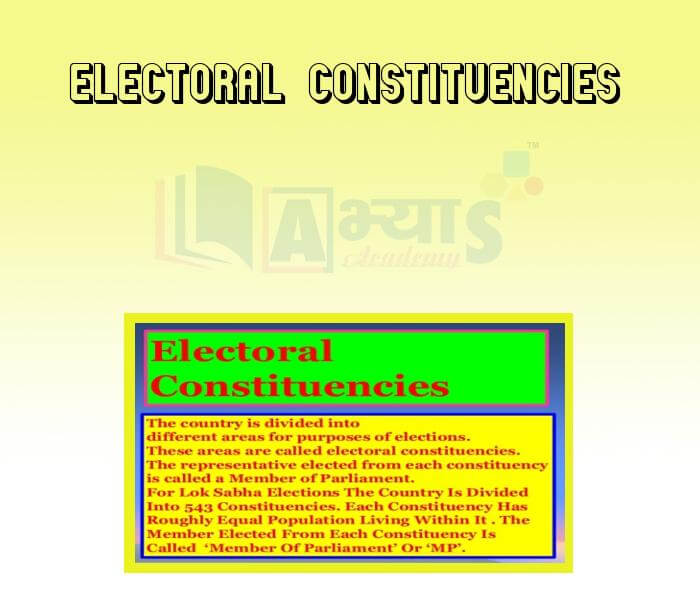Electoral Constituencies













Electoral Constituencies
Electoral Constituencies: In India, an area based system of representation is followed where the country is divided into different areas for purpose of elections. These are called Electoral Constituencies. Every voter who lives in an area elect one representative. For Lok Sabha election, India is divided into 543 constituencies. The representative elected from each constituency is called Member of Parliament or an MP. One of the features of a democratic election is that every vote has equal value. For Vidhan Sabha election, each state is divided into a specific number of assembly constituencies and the elected representative of each assembly constituency is called the Member of Legislative Assembly or an MLA. Each parliamentary constituency has within it several assembly constituencies. The same principle applies for Panchayat and Municipal elections. Each village or town is divided into different wards that are like constituencies. Each ward elects one member of the village or the Urban local body. Sometimes these constituencies are counted as ‘seats’ and each constituency represents one seat in the assembly.
Consider the following statement:
| |||
| Right Option : B | |||
| View Explanation | |||
Of the total Lok Sabha constituencies, the number of 'elected constituencies' is/are __________________ | |||
| Right Option : C | |||
| View Explanation | |||
India is divided into 543 constituencies. The representative elected from each constituency is called ___________________ | |||
| Right Option : D | |||
| View Explanation | |||
Students / Parents Reviews [10]
A marvelous experience with Abhyas. I am glad to share that my ward has achieved more than enough at the Ambala ABHYAS centre. Years have passed on and more and more he has gained. May the centre flourish and develop day by day by the grace of God.

Archit Segal
7thIt has a great methodology. Students here can get analysis to their test quickly.We can learn easily through PPTs and the testing methods are good. We know that where we have to practice

Barkha Arora
10thAbout Abhyas metholodology the teachers are very nice and hardworking toward students.The Centre Head Mrs Anu Sethi is also a brilliant teacher.Abhyas has taught me how to overcome problems and has always taken my doubts and suppoeted me.

Shreya Shrivastava
8thOne of the best institutes to develope a child interest in studies.Provides SST and English knowledge also unlike other institutes. Teachers are co operative and friendly online tests andPPT develope practical knowledge also.

Aman Kumar Shrivastava
10thAbhyas is a complete education Institute. Here extreme care is taken by teacher with the help of regular exam. Extra classes also conducted by the institute, if the student is weak.

Om Umang
10thMy experience was very good with Abhyas academy. I am studying here from 6th class and I am satisfied by its results in my life. I improved a lot here ahead of school syllabus.

Ayan Ghosh
8thMy experience with Abhyas academy is very good. I did not think that my every subject coming here will be so strong. The main thing is that the online tests had made me learn here more things.

Hiya Gupta
8thBeing a parent, I saw my daughter improvement in her studies by seeing a good result in all day to day compititive exam TMO, NSO, IEO etc and as well as studies. I have got a fruitful result from my daughter.

Prisha Gupta
8thAbhyas Methodology is very good. It is based on according to student and each child manages accordingly to its properly. Methodology has improved the abilities of students to shine them in future.

Manish Kumar
10thIt was a good experience with Abhyas Academy. I even faced problems in starting but slowly and steadily overcomed. Especially reasoning classes helped me a lot.
